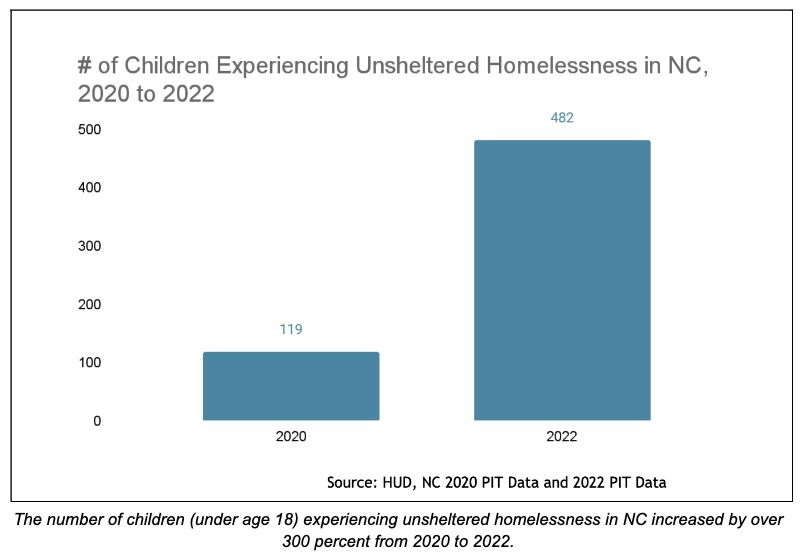
During this week’s Housing Call, Ryan Fehrman, Executive Director for the North Carolina Coalition to End Homelessness, discussed the findings in the 2022 Annual Homelessness Assessment Report (AHAR) Part 1 and recommended how to get involved in efforts to end homelessness in North Carolina and advocate for policy change.
“This [AHAR: Part 1] is an aggregation of the Point-in-Time (PIT) counts that communities do across the entire country,” Fehrman explained. The PIT count typically takes place during the last 10 days in January. Later this year, the second part of the report will be released that uses HMIS data to provide a more generalized estimate of the number of people in shelters over the course of the full year. The Department of Housing & Urban Development (HUD) began releasing the AHAR in 2007 to provide a snapshot of homelessness and shelter inventory across the United States. Trends that emerge from the data inform policies, programmatic decisions, and funding for the homelessness system.
Fehrman walked us through some of the main findings and reflected on the trends shown throughout the 2022 AHAR: Part 1 both at a national and state level. Here are a few of those highlights for North Carolina:
- As part of a larger national trend, the number of people experiencing unsheltered homelessness is increasing in NC. Between 2020 and 2022, the number of North Carolinians experiencing unsheltered homelessness rose from 2,558 to 3,625.
- The number of NC families with dependent children experiencing homelessness (and in particular, unsheltered homelessness) is increasing.
AHAR: Part 1 data from 2020 and 2022 indicates that the number of families with dependent children experiencing homelessness rose from 809 to 855. In Raleigh/Wake County alone, the number of families with dependent children experiencing unsheltered homelessness rose from 4 to 161. The table below shows the number of children experiencing homelessness in North Carolina between 2020 to 2022.

In response to these trends, Fehrman said, “To see those numbers increase is certainly concerning, and this year will help us to determine if this is an ongoing trend or an anomaly related to the pandemic.” This statement is very timely. Several data methodology practices were impacted by the pandemic, and those impacts are still being seen, including in the PIT. However, despite the noted impacts of the pandemic on data collection capacity, unsheltered homelessness continues to impact individuals, families, and youth across North Carolina.
“Poverty and housing instability is bad in general, but certainly for young children, that is a traumatic experience that can impact their growth and development and performance in school.”
-Ryan Fehrman, Executive Director of NC Coalition to End Homelessness (NCCEH)
Key Highlights for the US
- The overall number of people experiencing homelessness was 582,500, which represents only a slight increase from 2020 (less than 1%).
- The vast majority (72%) of people experiencing homelessness are single men and single women. 28% of people counted were part of a family unit.
- Veteran homeless decreased by 11% over the last 2 years. Fehrman said this decrease is largely due to targeted resources and programs that have been successful in aiding veterans at risk of and experiencing homelessness.
- 30% of people experiencing homelessness have patterns of chronic homelessness. Chronic homelessness is defined as people with a disabling condition (mental, physical, substance-use related, etc.) that have been homeless for a year or more or have had 4 episodes of homelessness within the last 3 years.
- There was an 11% increase in the number of available beds for people experiencing or formerly experiencing homelessness. This number includes emergency shelter beds, transitional housing, rapid rehousing, permanent supportive housing, etc. The number of voucher-based beds in hotels and motels increased drastically as part of the pandemic response when many congregate shelters had lower capacity due to social distancing requirements. Fehrman noted that most of these non congregate shelter options have ended both within NC and across the US.
Disproportionate Impact
While homelessness and instability is an issue that spans across all demographic groups, data consistently shows disparities in who is feeling the brunt of this crisis. This is something Fehrman directly called out during our housing call this week: “There is a long history of discrimination and racism when it comes to our housing policy in this country, and we see that in the numbers of homeless folks….people of color [are] way overrepresented in our homeless population.” This year’s report indicates that people who identify as Black make up 12% of the total US population, yet they comprise 37% of all people experiencing homelessness and 50% of all people experiencing homelessness as a family unit.
Data Limitations
The PIT methodology has its limits. The data provides a snapshot about who is experiencing sheltered and unsheltered homeless on the night of the count, rather than over the course of the year. “In some ways, it’s easier to track our sheltered population, and certainly folks who receive HUD dollars through the Emergency Solutions Grant program or Continuum of Care funding [who] are required to participate,” Fehrman noted, explaining that some providers who don’t receive Federal dollars are less willing to share their shelter data for the PIT count.
Counting the unsheltered homeless population is more difficult. Larger urban areas often benefit from more volunteers and larger Street Outreach teams. NCCEH administers the North Carolina Balance of State Continuum of Care, which covers 79 of the state’s 100 counties. Fehrman noted that some of these counties lack capacity for street outreach and accurate counts of unsheltered homelessness.
It’s also worth noting that AHAR: Part 1 2022 draws comparisons to 2020, rather than 2021. “Our 2021 data has a big asterisk next to it,” Fehrman said, pointing to the many ways in which the pandemic impacted data collection. Vaccines weren’t widely available in January 2021, so HUD waived the unsheltered homelessness count requirement. In 2022, there were still some pandemic-related voucher-based beds skewing numbers.
As we head into the 2023 PIT count, Fehrman notes that there’s a high degree of uncertainty about what trends will emerge. “It will be interesting to see if our 2023 numbers are part of a larger trend of increases or if we see potential decreases as people potentially got assistance from programs like emergency rental assistance, which was a significant source of rent and utility [assistance] for low-income families coming out of the pandemic,” he said.
How to Get Involved
- Many CoCs use volunteers to assist with unsheltered PIT counts. Find your community’s CoC on this map and reach out to your local CoC contact in December or early next January to ask about opportunities to be trained as a volunteer to participate in the unsheltered portion of the 2024 count.
- Sign up for NCCEH updates to stay in the loop about volunteer opportunities and how you can use your voice to advocate for specific legislation.
A big thank you to Ryan Fehrman for joining our Housing Call this week! If you are interested in hearing more about this topic or have suggestions for others that you’d like us to dive into, please email Anna Patterson at apatterson@nchousing.org or Stephanie Watkins-Cruz at swatkinscruz@nchousing.org.








